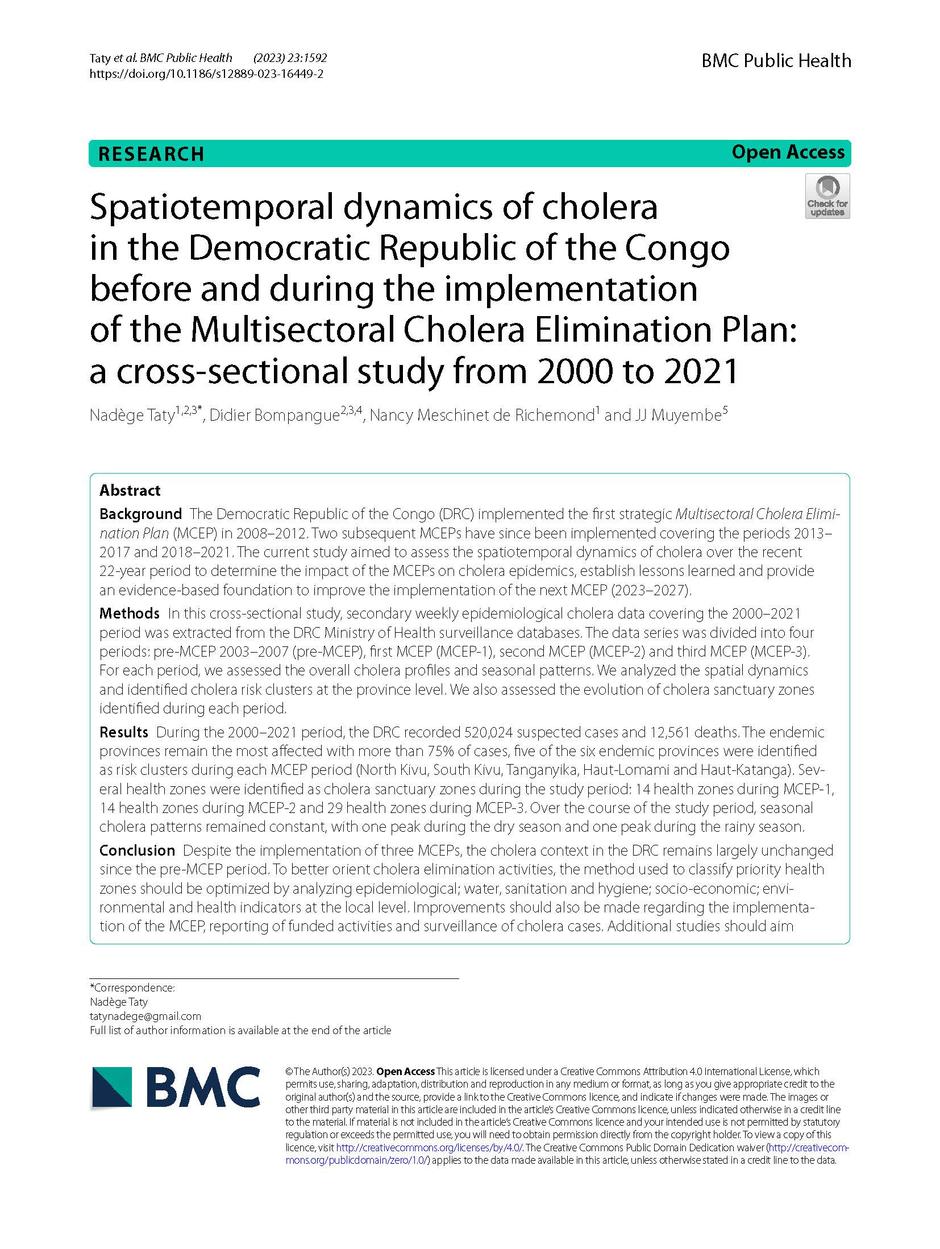The Democratic Republic of the Congo (DRC) was one of the first countries in the world to develop a strategic plan to eliminate cholera. A recent study has assessed the characteristics of cholera outbreaks in the DRC during the recent 22-year period to determine the effects of the elimination plans on disease dynamics and establish lessons learned. Overall, these results provide an evidence-based foundation to strengthen efforts to eliminate cholera in the country by the year 2030.
The Democratic Republic of the Congo (DRC) was one of the first countries in the world to develop a strategic Multisectoral Cholera Elimination Plan (MCEP). The first plan was implemented in 2008-2012 (MCEP-1) (1). Two subsequent MCEPs have since been implemented covering the periods 2013-2017 (MCEP-2) and 2018-2021 (MCEP-3). The MCEP aims to address the factors responsible for cholera outbreaks in key health zones, termed cholera sanctuaries. As cholera sanctuaries report cholera cases in a quasi-continuous manner, these health zones play a major role in cholera dynamics in the country. Cholera sanctuary zones are classified based on epidemiological and environmental parameters (e.g., presence of a lake) (2).
A recent study published in BMC Public Health by Taty et al. has assessed the characteristics of cholera outbreaks in the DRC to determine the effects of the elimination plans on disease dynamics and establish lessons learned. From 2000 to 2021, the DRC recorded 520,024 suspected cholera cases and 12,561 deaths. This 22-year timeframe was assessed in four periods: the period prior to the implementation of the first MCEP (2003-2007; pre-MCEP), first MCEP (MCEP-1), second MCEP (MCEP-2) and third MCEP (MCEP-3) (2).
In the DRC, provinces are considered cholera-endemic if they report cases in a continuous or metastable manner and have at least one cholera sanctuary. During the study period, the endemic provinces remained the most affected with more than 75% of cases, five of the six endemic provinces located in eastern DRC were identified as risk clusters during each MCEP period (e.g., North Kivu, South Kivu, Tanganyika, Haut-Lomami and Haut-Katanga). However, the proportion of cases in endemic provinces decreased over time, while the proportion of cases in non-endemic provinces increased. Furthermore, the number of health zones that were classified as cholera sanctuaries gradually increased over time, with 14 cholera sanctuaries during MCEP-1 and MCEP-2 followed by 29 cholera sanctuaries during MCEP-3 (2).
As it appears that the cholera context in the DRC has not improved since the implementation of the MCEPs, the authors have established a set of recommendations based on these results. To better orient cholera elimination activities, the method used to classify cholera sanctuaries should be optimized by analyzing epidemiological; water, sanitation and hygiene; socio-economic; environmental; and health indicators at the local level. Improvements should also be made regarding the implementation of the MCEP, reporting of funded activities and surveillance of cases. Additional studies should aim to identify specific gaps in the coordination of interventions at the local, national and international levels. Overall, these results provide an evidence-based foundation to guide the next MCEP (2023-2027) and strengthen efforts to eliminate cholera in the DRC by the year 2030 (2).
REFERENCES:
1-Muyembe JJ, Bompangue D, Mutombo G, Akilimali L, Mutombo A, Miwanda B, et al. Elimination of cholera in the democratic Republic of the Congo: the new national policy. J Infect Dis. 2013 Nov 1;208 Suppl 1:S86-91.
2-Taty N, Bompangue D, de Richemond NM, Muyembe J. Spatiotemporal dynamics of cholera in the Democratic Republic of the Congo before and during the implementation of the Multisectoral Cholera Elimination Plan: a cross-sectional study from 2000 to 2021. BMC Public Health. 2023 Aug 22;23(1):1592.
THE PUBLICATION:


